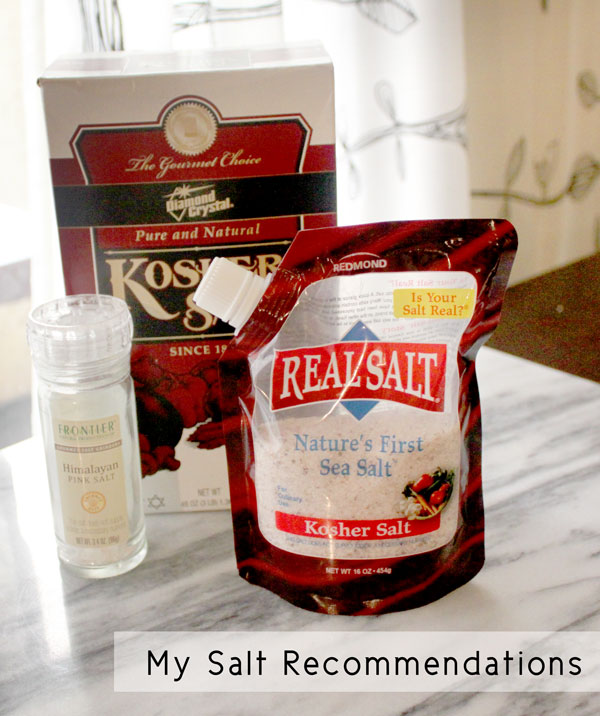Salt is an important ingredient that every cook relies on to bring out the flavors in a dish. But, it has a bad reputation as being an unhealthy ingredient, especially for heart health. Although I’m not a doctor, (and you should still consult a medical professional if you have a heart condition) I thought you guys might be interested in my thoughts on salt and the brands I use for difficult cooking applications.
In my recipes, I call for sea salt almost all the time. Usually I use Himalayan sea salt, because it’s unrefined and full of trace minerals. Consuming minerals, whether it’s from bone broth or from your salt is always a good idea. Mineral deficiencies can cause a ton of different health problems from heart disease to chronic pain. One of the main reasons the paleo community eliminates or reduces grains and beans is because of phytic acid found in these foods. This anti-nutrient binds to minerals in digestive tract before they can be absorbed or utilized. Another reason, we reduce grains and beans is to reduce sugar consumption. Now if you’re carefully monitoring your salt intake, and you still want your food to taste good, you’ll likely start consuming more sugar. Salt, fat, and sugar are the trifecta of deliciously addictive food. Likely, if you’re reducing salt, you were also told to reduce fat, which leaves you with sugar as the only option for making your food taste delicious. After reading Wheat Belly, which was written by cardiologist William Davis, MD, sugar is the last thing you should consume with a heart problem.
Lately, I’ve started using Real Salt by Redmond Trading Company. It’s unrefined salt from Utah that’s full of minerals, and without chemicals or anti-caking agents. I love the packaging, because it’s already roughly ground up and comes in a pourable and resealable pouch, which makes it easier for me to measure out amounts when I create or follow recipes. I also use Diamond Crystal Kosher Salt that I buy in bulk from Costco, when I want to bake something on top of salt (such as garlic or sweet potatoes) or brine or dry rub a large piece of meat. Salt baking is a great way to cook food without wrapping it in aluminum foil. Although, I do cover the baking dish in foil to keep in moisture. The salt helps absorb some of the moisture, making it a ideal environment for baking certain types of food. Plus, I like to check on my food, and if it’s tightly wrapped in foil, I can’t tell how brown it’s getting, and using less aluminum is also good for your health. This salt is also the salt recommended in All About Roasting by Molly Stevens. Since her recipes are on the more advanced side, (at least if you consider cooking a large piece of meat or fish advanced) I like to follow her recipes as precisely as I can. (This is super rare for me since I always switch out ingredients and change up amounts) I tried out her turkey recipe on Thanksgiving (with no trial run) and it came out great!
I do think salt can be harmful, especially in the large amounts found in processed food. There is usually a lot of other harmful ingredients in processed food as well, so cooking food yourself and from scratch should be more important than worrying about salt intake. If you are still concerned about salt, season the food when you’re finished cooking, so you can monitor it yourself and only add the smallest amount necessary. Organic kelp granuales, which are usually found near the seaweed section of the grocery store, can be a great salt alternative. Although I use it more as a seasoning that’s a little salty, rather than a replacement for salt.
Sources

